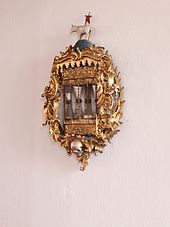Evangelical Lutheran parish church Heilgersdorf
The Evangelical Lutheran parish Heilgersdorf in Upper Franconia Heilgersdorf , a district of Sesslach in Coburg , dates back to the 1758th
history
Heilgersdorf, initially a Sesslach branch, became an independent parish on December 10, 1364. Previously an old chapel had been replaced by a new building in 1361. In 1551 the Lords of Lichtenstein introduced the Reformation and six years later the chapel was demolished and a church was built, which was destroyed in the Thirty Years' War . In 1657 the community had a wooden church built, which was followed by a massive church in 1700, which was demolished in 1753 due to its dilapidation.
Today's church was built between 1753 and 1758. Due to the great similarities between the church tower and the Lahmer castle church , the designer of the Heilgersdorf parish church is believed to be in the vicinity of Carl Friedrich von Zocha . There is no evidence of Johann Jakob Michael Küchel's involvement . The carpenter Johann Valentin Juchheim carried out the carpentry work. An extensive church renovation took place in the 1960s. The next one was in 1996.
New bells were hung in 1805, two of which were melted down in 1917 . The municipality replaced these three years later with cast steel bells. In World War II, two bells were melted down again. In 1955 three new bronze bells were consecrated and in 2007 the bell from 1920 was replaced.
Building description
The hall church in the rural baroque style stands on a hill, the former cemetery, which defines the townscape. It is surrounded by a high, massive sandstone wall. A single tower facade in the east and five-axis long sides with long windows in the upper area of the galleries and smaller windows underneath characterize the sandstone construction. Pilasters on the corners of the building and simple profile frames around the windows structure the facade. The entrance portals with shell decoration and curved gables are located in the central axes of the north, south and west sides. The coat of arms of the von Lichtenstein family are above the south and west portal.
The three-storey church tower is divided by five cornices that taper upwards . The high upper floor has chamfered corners and large, arched sound openings on each side that are band-framed. The upper end is a chamfered, square, narrow hood with slate covering, ball knob and point. On the sides of the tower there are spiral staircases as gallery entrances and the entrance to the sacristy , which is located in the basement of the tower, behind the altar.
The nave is spanned by a flat ceiling and is about 14 meters long, 10 meters wide and 10 meters high. It has two-story galleries, the lower one on three sides, the upper one on all four sides. There are two rows of benches on the long sides of the galleries. On the east side there is a pulpit altar and above it the organ gallery.
Furnishing
The pulpit is above the altar and is dated to 1758. The round body is adorned with numerous ornaments. Next to the pulpit hangs an hourglass with a gold case. It is probably also from the construction period. On the altar there is a wooden crucifix from the 19th century. Next to it is a baptismal font made of sandstone with the Lichtenstein coat of arms and angel figures. The round bowl with palmettes probably dates from the 17th century.
Four sandstone epitaphs are present in the sanctuary. The relief plates are dedicated to members of the von Lichtenstein family and are dated to 1529, around 1550, 1564 and 1584.
In 1955 three new bells were hung.
organ
When the church was rebuilt in 1753, an organ was probably installed above the altar and pulpit. There is evidence of organ repairs for the years 1799 and 1826. In 1860 the instrument had 16 stops. In 1885, the Coburg organ builder Anton Hasselbarth built a new organ on the west gallery in the ruling estate, which was returned to the old gallery above the altar pulpit wall in 1966. The instrument has 18 stops on two manuals and a pedal . The gaming table is on the west gallery. The organ brochure dates from 1966. It consists of three rectangular pipe fields of which the middle one is slightly higher. The pipe lengths drop from the outside inwards. The organ was restored in 2018. The instrument with its 912 pipes was expanded to include 22 registers, a veil was installed in front of the front pipes and a cymbal star was installed.
Parish
In addition to Heilgersdorf and Trammershof, the church district includes the neighboring towns of Seßlach , Wiesen , Rothenberg , Hattersdorf , Eckersdorf and Heinersdorf . There is a branch church in Bischwind .
Web links
Individual evidence
- ↑ a b evangelische-kirchengemeinde-heilgersdorf.de: The history of our church community
- ^ Roland Kunzmann: The church buildings of Johann Jakob Michael Küchel . Dissertation, University of Bamberg 2005, p. 311f
- ^ A b Hans Karlinger : The Art Monuments of Lower Franconia & Aschaffenburg, Booklet XV. District Office Ebern, Munich 1916, p. 109f
- ^ Lothar Hofmann: Monuments Region Coburg - Neustadt - Sonneberg: Places of contemplation and prayer. Historical sacred buildings. A guide through the churches in the districts of Coburg and Sonneberg . Verlag Gerätemuseum des Coburger Land, Ahorn 2007, ISBN 3-930531-04-6 , p. 88
- ↑ evangelische-kirchengemeinde-heilgersdorf.de: Church in Heilgersdorf
- ^ Hermann Fischer, Theodor Wohnhaas: Alte Orgeln im Coburger Land, Part IV. Yearbook of the Coburg Landesstiftung 1980, p. 128f
Coordinates: 50 ° 9 ′ 52.1 ″ N , 10 ° 49 ′ 38.9 ″ E


